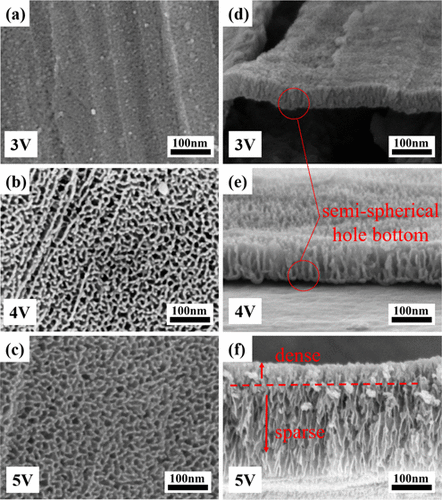当前位置:
X-MOL 学术
›
J. Phys. Chem. C
›
论文详情
Our official English website, www.x-mol.net, welcomes your
feedback! (Note: you will need to create a separate account there.)
Growth Model of the Tin Anodizing Process and the Capacitive Performance of Porous Tin Oxides
The Journal of Physical Chemistry C ( IF 3.3 ) Pub Date : 2020-01-23 , DOI: 10.1021/acs.jpcc.9b09648 Puying Li 1 , Dongmei Niu 1 , Mingfei He 2 , Hao Huang 1 , Zongrong Ying 1 , Haoqing Xu 1 , Junwu Zhu 1 , Xufei Zhu 1
The Journal of Physical Chemistry C ( IF 3.3 ) Pub Date : 2020-01-23 , DOI: 10.1021/acs.jpcc.9b09648 Puying Li 1 , Dongmei Niu 1 , Mingfei He 2 , Hao Huang 1 , Zongrong Ying 1 , Haoqing Xu 1 , Junwu Zhu 1 , Xufei Zhu 1
Affiliation

|
Nanoporous tin oxide layers were fabricated in NaOH during potentiostatic anodization at a low potential. With increasing potential, the nanochannel became fragmentized and a stacked morphology was formed. The total anodizing current was separated into ionic current and electronic current to explain the various morphologies of nanotubes. The ionic current determines ion migration and oxide growth. The electronic current determines oxygen evolution, porous structure formation, and oxide volume expansion. The continuous decline of the total current–time curve at 8 V was explained by a capacitor model. Through cyclic voltammetry, it was proposed that the stacked morphology exhibits a high specific capacitance (11.36 mF cm–2). Extending the annealing time can increase the crystallinity, thus improving the capacitive performance. The stacked morphology allows electrolytes to permeate the entire portion of the nanochannel more evenly, increasing the effective surface area of the electrode in the electrochemical process and thus improving the capacitive properties. The formation of a stacked morphology is related to the intense release of oxygen gas.
中文翻译:

锡阳极氧化过程的生长模型和多孔氧化锡的电容性能
在低电位的恒电位阳极氧化过程中,在NaOH中制备了纳米多孔氧化锡层。随着潜力的增加,纳米通道变得碎片化并形成了堆叠的形态。将总阳极氧化电流分为离子电流和电子电流,以解释纳米管的各种形态。离子电流决定离子迁移和氧化物生长。电流决定了氧气的释放,多孔结构的形成以及氧化物的体积膨胀。电容器模型解释了在8 V时总电流-时间曲线的连续下降。通过循环伏安法,建议堆叠的形态表现出高的比电容(11.36 mF cm –2)。延长退火时间可以增加结晶度,从而改善电容性能。堆叠的形态允许电解质更均匀地渗透到纳米通道的整个部分,从而增加了电化学过程中电极的有效表面积,从而改善了电容性能。堆叠形态的形成与氧气的大量释放有关。
更新日期:2020-01-24
中文翻译:

锡阳极氧化过程的生长模型和多孔氧化锡的电容性能
在低电位的恒电位阳极氧化过程中,在NaOH中制备了纳米多孔氧化锡层。随着潜力的增加,纳米通道变得碎片化并形成了堆叠的形态。将总阳极氧化电流分为离子电流和电子电流,以解释纳米管的各种形态。离子电流决定离子迁移和氧化物生长。电流决定了氧气的释放,多孔结构的形成以及氧化物的体积膨胀。电容器模型解释了在8 V时总电流-时间曲线的连续下降。通过循环伏安法,建议堆叠的形态表现出高的比电容(11.36 mF cm –2)。延长退火时间可以增加结晶度,从而改善电容性能。堆叠的形态允许电解质更均匀地渗透到纳米通道的整个部分,从而增加了电化学过程中电极的有效表面积,从而改善了电容性能。堆叠形态的形成与氧气的大量释放有关。











































 京公网安备 11010802027423号
京公网安备 11010802027423号